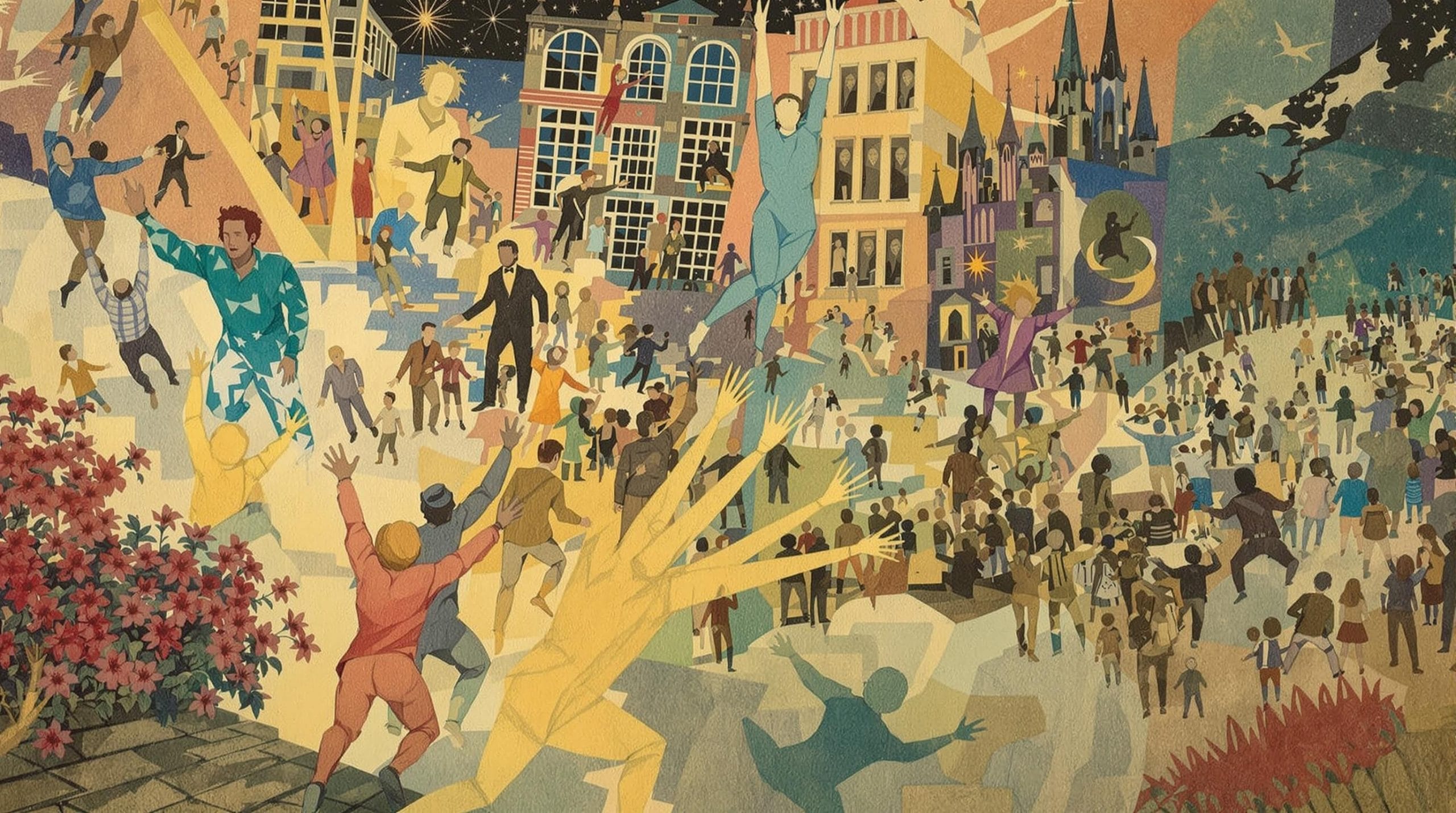Strauss-Howe Generational Theory and the Fourth Turning
The Strauss-Howe Generational Theory suggests that history unfolds in predictable 80-100 year cycles broken into four distinct phases or “turnings” that shape society’s mood and values. According to the theory’s originators, we are currently experiencing the Fourth Turning – a crisis period that began in the mid-2000s, characterized by institutional failure and collective urgency that could lead to transformative change by the mid-2020s.
Key Takeaways
- The theory divides historical cycles into four 20-25 year phases: High, Awakening, Unraveling, and Crisis
- Each generation belongs to one of four archetypes: Artists (Silent), Prophets (Boomers), Nomads (Gen X), and Heroes (Millennials)
- The current Fourth Turning began around 2005 and may culminate between 2020-2025
- Previous Fourth Turnings include the American Revolution and Great Depression/WWII periods
- Despite academic criticisms, the theory offers a useful framework for understanding generational dynamics
Understanding the Four Turnings Cycle
William Strauss and Neil Howe first described their generational theory in their 1991 book “Generations” and further expanded it in “The Fourth Turning” (1997). Their central idea proposes that history follows a predictable pattern divided into four distinct phases that together create a complete cycle called a saeculum, lasting roughly 80-100 years.
Each turning represents a distinct societal mood that shapes everything from politics to culture. The First Turning (High) brings strong institutions and social conformity. The Second Turning (Awakening) challenges these institutions with idealism. The Third Turning (Unraveling) sees increasing institutional distrust and individualism. Finally, the Fourth Turning (Crisis) represents a period of upheaval when society rebuilds its institutions.
According to Strauss and Howe, these cycles aren’t random but follow a natural rhythm tied to human lifespans and generational succession patterns. Each generation experiences these turnings at different life stages, creating distinct generational personalities.
The Last Complete Cycle in American History
To understand how these cycles work in practice, let’s look at the most recent complete saeculum in American history:
First Turning (High, 1946-1964): The post-WWII era featured unprecedented economic growth, suburban expansion, and strong institutional trust. The Silent Generation entered adulthood during this period, embracing conformity and stability after the previous crisis.
Second Turning (Awakening, 1964-1984): This period saw the rise of the counterculture movement, civil rights activism, and anti-war protests. Baby Boomers, entering young adulthood, challenged established norms and institutions, prioritizing personal freedom and spiritual exploration.
Third Turning (Unraveling, 1984-2005): As Generation X came of age, society experienced growing cynicism toward institutions. The era featured deregulation, culture wars, and increasing polarization. Individual success often trumped communal values during this period of prosperity mixed with anxiety.
Fourth Turning (Crisis, 2005-present): Beginning roughly with the 2008 financial crisis, this turning has featured mounting institutional failures, political extremism, and economic uncertainty. Millennials, as the Hero archetype, are positioned to lead through this transformative crisis.
The Four Generational Archetypes
Central to the Strauss-Howe theory are four generational archetypes that appear in the same sequence throughout history. Each generation’s collective personality is shaped by which turning they experience during their formative years:
- Artist (Silent Generation, born 1925-1942): Growing up during a crisis, they become adaptive, risk-averse, and focused on consensus-building. They value social order and pragmatism.
- Prophet (Baby Boomers, born 1943-1960): Growing up during a High, they become idealistic visionaries focused on values and principles. They drive awakenings and moral crusades.
- Nomad (Generation X, born 1961-1981): Growing up during an Awakening, they develop into practical, independent problem-solvers. They’re skeptical of institutions and value self-reliance.
- Hero (Millennials, born 1982-2005): Growing up during an Unraveling, they become civic-minded, optimistic team players. They’re primed to lead during crisis periods.
Each archetype plays a different role as society moves through the four turnings. For example, during the current Fourth Turning, Baby Boomers (Prophets) provide moral vision, Gen Xers (Nomads) offer practical leadership, and Millennials (Heroes) drive collective action to resolve the crisis.
Our Current Fourth Turning: Signs and Indicators
Strauss and Howe identified the mid-2000s as the beginning of our current Fourth Turning, with several key indicators suggesting we’re now approaching its climax:
- Economic disruption: The 2008 financial crisis, widening inequality (top 1% holding 32% of U.S. wealth as of 2023), and mounting debt issues
- Political fragmentation: Rising populism, erosion of bipartisan norms, and increasing polarization
- Institutional failures: Declining trust in government, media, and other social institutions
- Global instability: Climate crises, pandemic disruptions, geopolitical tensions
According to the theory, this Fourth Turning will likely reach its decisive moment between 2020-2025, potentially involving a paradigm-shifting event that forces society to rebuild its core institutions. The resulting changes may be as significant as those following the American Revolution or World War II, creating a new civic order that will shape the next saeculum.
Recent events like the COVID-19 pandemic, social justice movements, and political upheavals may represent the accelerating crisis that Strauss and Howe predicted, though the ultimate resolution remains uncertain.
Historical Precedents for Fourth Turnings
To understand what might lie ahead, it’s helpful to examine previous Fourth Turnings in American history:
The American Revolution (1773-1794): Beginning with the Boston Tea Party and ending with Washington’s presidency, this crisis period resulted in a completely new constitutional order and national identity.
The Civil War (1860-1865): This intense but shorter crisis resolved fundamental questions about national unity and slavery, reshaping American institutions for decades to come.
The Great Depression and World War II (1929-1945): Economic collapse followed by global conflict led to the creation of new social welfare systems, international institutions, and America’s emergence as a superpower.
In each case, the Fourth Turning resolved with new institutions and a reshaped social order that provided stability for the subsequent First Turning. If the pattern holds, our current crisis should similarly resolve with renewed social cohesion and institutional trust.
Scholarly Reception and Criticisms
While the Strauss-Howe theory has gained significant popular influence, it has faced substantial criticism from academic historians and social scientists:
Many scholars argue the theory is overly deterministic, forcing complex historical events into a predetermined pattern. The focus on cycles may oversimplify the role of individual agency, technological change, and unpredictable events in shaping history.
Critics also note the theory’s Anglo-American bias, as it draws primarily from British and American historical examples while largely ignoring non-Western societies. The emphasis on generational cohesion may also overlook important divisions within generations based on class, race, gender, and other factors.
Despite these criticisms, the theory remains influential in marketing, corporate planning, and even some policy circles because it provides a compelling narrative framework for understanding social change. Even skeptics acknowledge that generational differences do exist and can influence social attitudes and behaviors, even if not in the rigid cyclical pattern Strauss and Howe describe.
Navigating the Fourth Turning’s Resolution
If Strauss and Howe are correct, we are now approaching the climax of our current Fourth Turning, with resolution expected by the mid-2020s. What might this resolution look like?
The authors suggest that Fourth Turnings typically resolve with the creation of new civic orders and institutional structures that address the core problems revealed during the crisis. They also predict that Millennials, as the Hero generation, will play a pivotal leadership role in this process, much as the GI Generation did during the Great Depression and World War II.
Possible outcomes include reformed political institutions, new economic frameworks to address inequality, and transformed approaches to global challenges like climate change. However, Strauss and Howe emphasize that the specific nature of these changes depends on the choices made by individuals and leaders during the crisis period.
While the theory cannot predict exact events, it suggests that after this period of turbulent change, society will enter a new First Turning characterized by renewed institutional trust and social consensus. Whether this proves accurate remains to be seen, but the Strauss-Howe framework continues to provide a thought-provoking lens for understanding our present moment of uncertainty and transformation.
Sources
wikipedia.org/Strauss–Howe_generational_theory
shortform.com/blog/what-is-the-fourth-turning
supersummary.com/the-fourth-turning/summary
latest video
news via inbox
Nulla turp dis cursus. Integer liberos euismod pretium faucibua





